About Cosmic Flash & Earth Flash
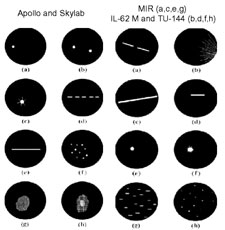 Cosmic Flash explorers an extraordinary phenomenon in space: Buzz Aldrin reported after the Apollo 11 flight to the Moon in 1969 for the first time about an astonishing sensorial experience: He saw light flashes even with the eyes closed. Years later, further experiments identified the origin of this entoptic phenomenon on the astronaut‘s retina in the direct impact of high energetic cosmic rays that originate from the dephts of space. Around 80 per cent of the astronauts report about this flashy reaction that appear in various forms like luminous dots, streaks, stars or even clouds (see left).
The light flashes are an almost exclusive phenomenon for space travellers because the heavy radiation is shielded by the earth atmosphere. There were only a few reports about a similar visual experience on earth. In the 1950‘s a researcher in the USA exposed him self in a dangerous self-experiment to the particle beam in an accelerator facility. Also brain cancer patients exposed to ion beams for therapeutic purposes report about light flashes.
Cosmic Flash explorers an extraordinary phenomenon in space: Buzz Aldrin reported after the Apollo 11 flight to the Moon in 1969 for the first time about an astonishing sensorial experience: He saw light flashes even with the eyes closed. Years later, further experiments identified the origin of this entoptic phenomenon on the astronaut‘s retina in the direct impact of high energetic cosmic rays that originate from the dephts of space. Around 80 per cent of the astronauts report about this flashy reaction that appear in various forms like luminous dots, streaks, stars or even clouds (see left).
The light flashes are an almost exclusive phenomenon for space travellers because the heavy radiation is shielded by the earth atmosphere. There were only a few reports about a similar visual experience on earth. In the 1950‘s a researcher in the USA exposed him self in a dangerous self-experiment to the particle beam in an accelerator facility. Also brain cancer patients exposed to ion beams for therapeutic purposes report about light flashes.
The light flashes are a challenge for future long term space missions in outer space, because beyond the earth magnetic shield the impact of cosmic radiation is much higher. Cosmic flash reflects all the facets of the light flash phenomenon. There are two variants of the project in development. In the space based project astronauts transmit life their light flash experiences in space the earth and trigger with every light flash they have a large flashing light installation. The earth based project Earth flash develops harmless alternatives to enable the experience of light flashes on earth. This experience helps to prepare astronauts psychologically to that phenomenon in space. As a walkable installation the experience is made accessible also to a larger audience.
PROTOCOL
26 September - Earth flash at IAC Chiaki Mukai
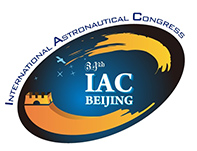 At the 64th International Astronautical Congress (IAC) in BejingI did present Earth Flash in the session in the session E5.4 "Space as Artistic Medium" which I did also co-chair. Accompanying to the presentation an extended resumée on the Earth Flash project appeared in the IAC's conference proceedings.
At the 64th International Astronautical Congress (IAC) in BejingI did present Earth Flash in the session in the session E5.4 "Space as Artistic Medium" which I did also co-chair. Accompanying to the presentation an extended resumée on the Earth Flash project appeared in the IAC's conference proceedings.
The huge congress gave the opportunity to talk about radiation biological issues with various experts. Among others I could interview the Japanese astronaut Chiaki Mukai about her light flash experiences during her two space missions to the ISS. ![]()
![]()
30 June 2013 - New Earth flash experiment

 June 2013
June 2013
Further two self-experiments resulted in the first retinal light flash experiences. Again in collboration with Prof. Thomas Kammer head of the Transcranial Stimulation Laboratory at University Clinics in Ulm the excitation of the retina was tested by transcranial stimulation and with electrodes. This time the eyes were dark adapted. Pulses of electric and magnetic stimuli up to a frequency of 20 Hz resulted in a week light flash experience. The big surprise was the discovery of a much more significant light flash applying a static DC current. With the relatively large electrodes the current only caused a slight prickling on the skin. But when the current (max. 1mA) was switched on a signficant bluish cloud appeared in the eye of the anode side, which disappeared again quickly after a few seconds. When swithching of the current a similar figure was flashing up at the cathode side.
The results were presented officially in the radiation session at the Humans in Space Symposium (HIS 2013) in Cologne on 9 July 2013. There I had also the opportunity to interview Lawrence Pinsky who initiated the first light flash research for the Apollo program.![]()
![]()
30 June 2011 - Frank de Winne's light flashes
Astronaut Frank de Winne (ESA) reports at the ESA Topical Team Arts & Sciences meeting on his flashes at the ISS. De Winne became the first European commander of the ISS.
(Clip: ![]() mp4, , 2 Mb, 45 sec.)
mp4, , 2 Mb, 45 sec.) ![]()
![]()
16 June 2011 - John Grunsfeld's coloured light flashes
Preparing the project "From the Distant Past" at the Space Telescope Science Institute (STScI) in Baltimore, Tim Otto Roth met the astronaut John Grunsfeld (NASA). The physicist, who took part in serveral service missions for the Hubble Space Telescope, reported about the colouring of several light flashes in space. (oral interview/ no record)
![]()
![]()
6-10 July 2009 - Double Strand Break in Cologne, Heavy Ions Symposium
On invitation by Günter Reiz (DLR) and Oliver Angerer (ESA) it was possible to attend the Heavy Ions in Therapy and Space Symposium organized by DLR. I got new insights in the destructive power which heavy nuclei develop at a certain energy level in living tissues. The consequences are for instance damages difficult to repair, as for instance double strand breaks of the DNA.![]()
![]()
28 May 2009 - Particle crash in space
'Teilchencrash im All - kosmische Strahlung und das Raumschiff Erde', talk at lecture series "Kultur und Raumfahrt", Landesmuseum Braunschweig, Burgplatz 1, 19:00![]()
![]()
26 February 2009 - Exploring Magnetophosphenes : a self-experiment
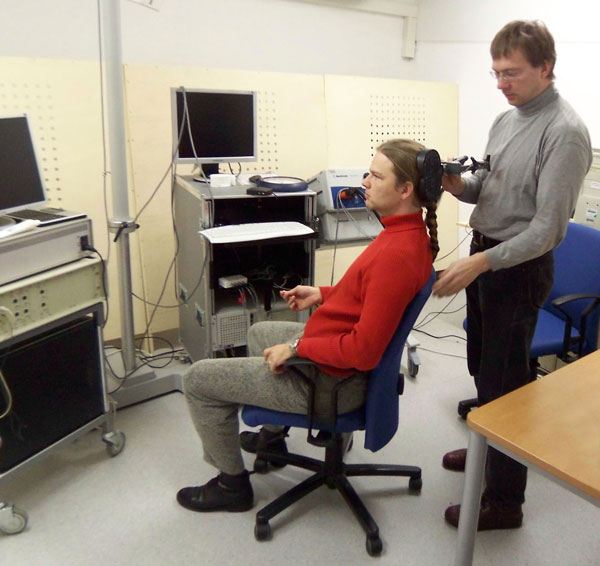 Today the approach by the US-American physicist Tobias exploring the phenomenon of light flashes by exposing his own head to the beam of a particle accelerator sounds quite adventurous. A more or less riskless alternative to experience a kind of light flash on earth might be the exposure of the visual system to changing high magnetic fields. On 26 February 2009 a first self-experiment took place thanks to the help of Dr. Thomas Kammer/ Head of the Laboratory for Transcranial Magnetic Stimulation (TMS), University of Ulm: Thomas Kammer stimulated with short magnetic impulses (a single amplitude of ca. 4000 Hz) zones in the visual cortex. The most explicit phosphene was recorded stimulating the left occipital resulting in a greyish streak which was slight bluered by grainy colour dots on the right side of the visual field:
Today the approach by the US-American physicist Tobias exploring the phenomenon of light flashes by exposing his own head to the beam of a particle accelerator sounds quite adventurous. A more or less riskless alternative to experience a kind of light flash on earth might be the exposure of the visual system to changing high magnetic fields. On 26 February 2009 a first self-experiment took place thanks to the help of Dr. Thomas Kammer/ Head of the Laboratory for Transcranial Magnetic Stimulation (TMS), University of Ulm: Thomas Kammer stimulated with short magnetic impulses (a single amplitude of ca. 4000 Hz) zones in the visual cortex. The most explicit phosphene was recorded stimulating the left occipital resulting in a greyish streak which was slight bluered by grainy colour dots on the right side of the visual field:
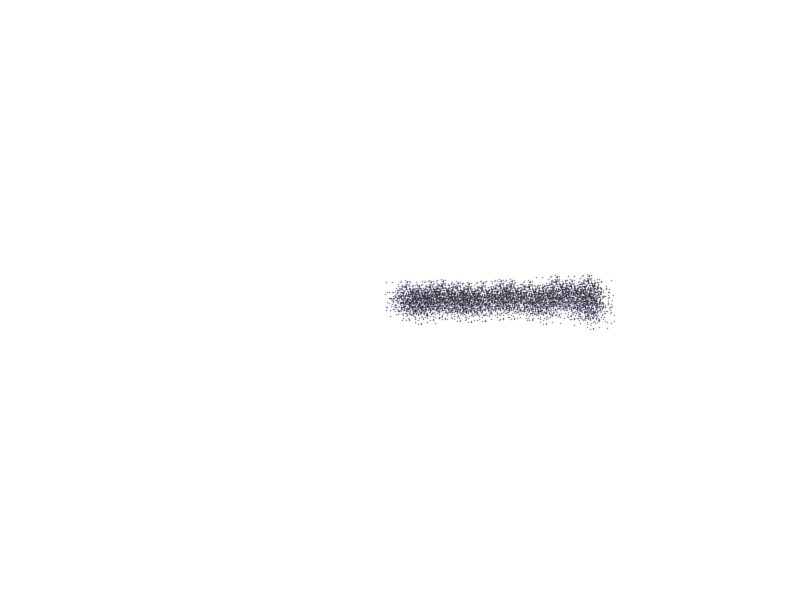
Applying a more or less diffuse magnetic field it was expected to “see” a dotlike or cloudy entoptic phenomenon. So the shape of a streak was quite remarkable.
The magnetosphenes caused in the cortex differ from retinal phosphenes. Because they are imposed on the visual information they can be seen at different levels of brightness. A short session tried also to stimulate an effect in the eye. But there was just a very soft unidentifiable cloudy impression.
![]()
![]()
8/9 November 2007 - International Space Exploration Conference, Berlin : Christer Fugelsang's ligh flashes
 Cosmic Flash was presented as video proposal on the International Space Exploration Conference held by ESA and DLR at the Axica Center in Berlin. The video presentation was part of The Arts Catalyst's presentation of their study for the cultural ulization of the ISS. Watch the video proposal for the International Space Exploration Conference 2007 in Berlin (
Cosmic Flash was presented as video proposal on the International Space Exploration Conference held by ESA and DLR at the Axica Center in Berlin. The video presentation was part of The Arts Catalyst's presentation of their study for the cultural ulization of the ISS. Watch the video proposal for the International Space Exploration Conference 2007 in Berlin (![]() , Mpg, 131 Mb, 7 min.).
, Mpg, 131 Mb, 7 min.).
 At the conference the Swedish astronaut Christer Fuglesang (ESA) was interviewed by Alexander van Dijk and Tim Otto Roth. The physicist reported about his light flashes on the ISS during the STS-116 (Celsius) mission in december 2006.
At the conference the Swedish astronaut Christer Fuglesang (ESA) was interviewed by Alexander van Dijk and Tim Otto Roth. The physicist reported about his light flashes on the ISS during the STS-116 (Celsius) mission in december 2006.
(Clip: ![]() mp4, , 10 Mb, 1,5 min.)
mp4, , 10 Mb, 1,5 min.)
29 October 2007 - Earth based flashes at GSI
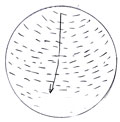 Dieter Schardt opened the door for a visit at the Gesellschaft für Schwerionenforschung (GSI) in Darmstadt. Dieter Schardt and his team colleagues discovered that during the radiation therapy with heavy nuclei brain cancer patients reported about light flash phenomena which have formal parallels to the phosphenes astronautes have in space. In one of the studies the patients made drawings of their light flashes (see left). Here the research group's most recent paper.
Dieter Schardt opened the door for a visit at the Gesellschaft für Schwerionenforschung (GSI) in Darmstadt. Dieter Schardt and his team colleagues discovered that during the radiation therapy with heavy nuclei brain cancer patients reported about light flash phenomena which have formal parallels to the phosphenes astronautes have in space. In one of the studies the patients made drawings of their light flashes (see left). Here the research group's most recent paper.
![]()
![]()
October 2007 - Turning cosmic air showers into art
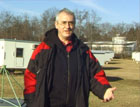 The earth atmosphere reacts like a giant detector for cosmic rays. The high energetic particles interact collide with molecules in atmosphere and inititate a cascade of secondary particles. These earth showers can be detetected with an array like KASCADE at KIT in Karlsruhe. The project leader Andreas Haungs explains in an interview two different ways of air shower detection with KASCADE and LOPES.
The earth atmosphere reacts like a giant detector for cosmic rays. The high energetic particles interact collide with molecules in atmosphere and inititate a cascade of secondary particles. These earth showers can be detetected with an array like KASCADE at KIT in Karlsruhe. The project leader Andreas Haungs explains in an interview two different ways of air shower detection with KASCADE and LOPES.
Clip: ![]() Mpg, , 15 Mb, 1 min.
Mpg, , 15 Mb, 1 min.
Only one year later Cosmic Revelation was realized in Karlsruhe transforming the KASCADE detector array by sixteen light sculptures into a flashig light field. The renown Oxford professor in art history Martin Kemp has summarised that novel concept bridging art and science:"A new art is encoding a new science."
![]() [Nature 458, 836]
[Nature 458, 836]
![]()
![]()
22/23 October 2007 - Productive collisions between art & nuclear physics in Rome
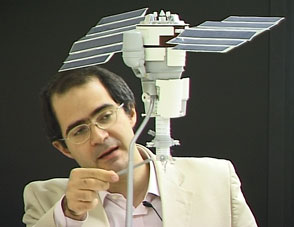 The Arts Catalyst London commisioned a video to document the Cosmic Flash proposal.
The Arts Catalyst London commisioned a video to document the Cosmic Flash proposal.
Marco Cassolino a leading scientists exploring the impact of cosmic rays in space was interviewed in Rome for the video. The Italian physicist explained the physcial background of cosmic rays and and the implications for human space flight. Watch the video proposal for the International Space Exploration Conference 2007 in Berlin (![]() , Mpg, 131 Mb, 7 min.).
, Mpg, 131 Mb, 7 min.).
Above all Tim Otto Roth presented his project in a guest talk: Cosmic Flash – productive collisions between art & nuclear physics", National Institue of Nuclear Physics (INFN), Tor Vergata University, Rome. ![]()
![]()
11 September 2006 - Alan Bean's first light flash in a moon crater
 One of the honorably guest at the Space Soon event was Alan Bean, one of the few remaining Apollo astronauts to walk on the Moon. He made his first flight into space aboard Apollo 12, the second manned mission to land on the Moon. In the interview Alan Bean reported on his first light flash appearing during the landing manover crossing a dark Moon crater.
One of the honorably guest at the Space Soon event was Alan Bean, one of the few remaining Apollo astronauts to walk on the Moon. He made his first flight into space aboard Apollo 12, the second manned mission to land on the Moon. In the interview Alan Bean reported on his first light flash appearing during the landing manover crossing a dark Moon crater.
Clip: ![]() mp4. , 10Mb, 40 sec.
mp4. , 10Mb, 40 sec.![]()
![]()
September 2006 - Cosmic Flash at Taking Control in London
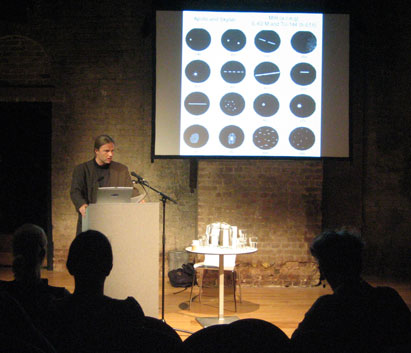 The study for the cultural utilization of the ISS comprising a series of project proposals was finished in 2006. The summary can be downloaded here.
The study for the cultural utilization of the ISS comprising a series of project proposals was finished in 2006. The summary can be downloaded here.
The concept of Cosmic flash was presented in September 2009 for the first time to the public in occasion the of the Symposium 'Taking Control' organized by the Arts Catalyst for the Space Soon exhibition in the Roundhouse London (pdf program).
2005/06 - Developing the idea of "Cosmic Flash"
 In 2005 Tim Otto Roth was invited by The Arts Catalyst in London to propose a project for their study into the cultural utilization of the ISS being prepared for the European Space Agency (ESA). During his investigations the Italian LAZIO experiment exploring the light flash observation by astronoauts in space was the finaly trigger for his idea of the project Cosmic Flash. Finally the proposal fused the artist's interests in astro particle physiscs and human space flight. A detailed proposal was worked out together with space engineer Alexander van Dijk. Above all the physicist Marco Cassolion and the astronaut and physicist Christer Fuglesang were consulted. Christer Fuglesang published in 2007 an important paper on light flashes: Using the human eye to image space radiation or the history and status of the light flash phenomena (NIMA).
In 2005 Tim Otto Roth was invited by The Arts Catalyst in London to propose a project for their study into the cultural utilization of the ISS being prepared for the European Space Agency (ESA). During his investigations the Italian LAZIO experiment exploring the light flash observation by astronoauts in space was the finaly trigger for his idea of the project Cosmic Flash. Finally the proposal fused the artist's interests in astro particle physiscs and human space flight. A detailed proposal was worked out together with space engineer Alexander van Dijk. Above all the physicist Marco Cassolion and the astronaut and physicist Christer Fuglesang were consulted. Christer Fuglesang published in 2007 an important paper on light flashes: Using the human eye to image space radiation or the history and status of the light flash phenomena (NIMA).
![]()
![]()
Winter 2005 - First physical exposure at the Jungfraujoch
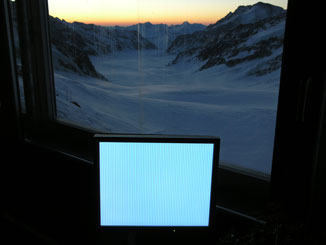 During the stay at the High Altitude Station Jungfraujoch in the Central Alpes in Switzerland Tim Otto Roth came in touch for the first time physcically with higher energetic cosmic rays. Due the altitude of 3500 meters above sea level the station is exposed to a much higher level of cosmic radition than at lower altitudes. The research stations played an important role in early astro particle physics. Preparing his installation 100 Days - 100 Imachinations in the library of the research station Tim Otto Roth came across a couple of documents illustrtating the early research in cosmic rays at the Jungfauchjoch, as photographs of the two week camp by von Salis on the Mönch (4107 m) to measure cosmic rays in 1926. More....
During the stay at the High Altitude Station Jungfraujoch in the Central Alpes in Switzerland Tim Otto Roth came in touch for the first time physcically with higher energetic cosmic rays. Due the altitude of 3500 meters above sea level the station is exposed to a much higher level of cosmic radition than at lower altitudes. The research stations played an important role in early astro particle physics. Preparing his installation 100 Days - 100 Imachinations in the library of the research station Tim Otto Roth came across a couple of documents illustrtating the early research in cosmic rays at the Jungfauchjoch, as photographs of the two week camp by von Salis on the Mönch (4107 m) to measure cosmic rays in 1926. More....







